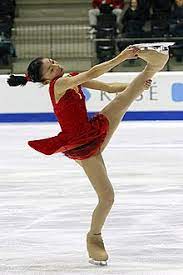Figure skating is a sport and an art form that involves individuals or pairs performing various jumps, spins, and other graceful movements on ice. The sport dates back to the mid-1800s, where it was first performed in England.
In competitive figure skating, skaters are judged based on their technical ability, execution, and artistic interpretation of the music they skate to. There are several disciplines within figure skating, including singles, pairs, ice dancing, and synchronized skating.
Singles skating involves an individual skater performing jumps, spins, and footwork, while pairs skating involves a male and a female skater performing similar elements in unison. Ice dancing is similar to pairs skating, but emphasizes the dancers’ interpretation of music and their footwork. Synchronized skating is a team event where 8-20 skaters perform coordinated movements and formations on the ice.
Figure skating requires a high level of physical fitness, strength, and coordination, as well as a great deal of practice and dedication. Skaters typically begin training at a young age and work with coaches to develop their technique and performance skills.
Figure skating has gained popularity around the world and is now a widely recognized Olympic sport. The sport is not only admired for its athleticism but also for the beauty and grace displayed by the skaters.

Equipment:
Figure skaters wear specialized boots with blades that are designed to glide smoothly on ice. The blades are sharpened to create edges that allow the skaters to perform jumps and other maneuvers. Skaters also wear tight-fitting costumes that are designed to enhance their movements and create a sense of elegance and fluidity.
Technique:
Figure skating requires a combination of technical ability and artistic expression. Skaters must master a variety of jumps, spins, footwork sequences, and lifts (in pairs skating) while maintaining proper posture, balance, and control. Technical elements are judged on their difficulty and execution, while artistic elements are evaluated based on factors such as musical interpretation, choreography, and presentation.
Competition:
Figure skating competitions take place at various levels, from local and regional events to national and international championships. Skaters compete in multiple rounds, performing short and long programs that are set to music. Judges evaluate the skaters based on a set of criteria and assign scores for each element and overall performance. The skater with the highest total score at the end of the competition is declared the winner.
Famous skaters:
Figure skating has produced many legendary skaters over the years, including Sonja Henie, Peggy Fleming, Dorothy Hamill, Michelle Kwan, Yuna Kim, and Evgenia Medvedeva. These skaters have not only excelled in competition but have also helped to popularize the sport and inspire future generations of skaters.
Training:
Figure skaters typically train for several hours a day, combining on-ice practice with off-ice conditioning, dance training, and choreography sessions. Skaters work closely with coaches to develop their skills and create programs that showcase their strengths and abilities. Many skaters also incorporate elements of ballet, gymnastics, and other disciplines into their training to improve their flexibility, strength, and overall performance.
Here are some additional details about figure skating:
Music:
Music is an essential component of figure skating, and skaters must choose their music carefully to match their style and personality. Skaters perform their routines to a variety of music, including classical, pop, and rock, and must synchronize their movements with the rhythm and tempo of the music.
Rules and regulations:
Figure skating is governed by a set of rules and regulations established by the International Skating Union (ISU). These rules specify the technical requirements for each element and outline the scoring system used to evaluate skaters’ performances. The rules also govern issues such as costumes, music selection, and athlete eligibility.
Off-ice training:
In addition to on-ice training, figure skaters must also engage in off-ice training to build strength, endurance, and flexibility. Off-ice training typically includes weightlifting, cardio exercise, stretching, and Pilates or yoga. Many skaters also work with sports psychologists or mental coaches to improve their focus, confidence, and resilience.
Injuries:
Figure skating is a physically demanding sport that can put a lot of stress on the body. Skaters are at risk for a variety of injuries, including sprains, strains, and fractures. They may also develop overuse injuries from repetitive movements or poor technique. Skaters must take care to warm up properly, use proper technique, and take adequate rest and recovery time to avoid injury.
Culture:
Figure skating has developed a rich culture over the years, with its own unique terminology, traditions, and fan base. Fans of the sport are known for their enthusiasm and loyalty, and figure skating competitions often draw large crowds and television audiences. The sport has also inspired a variety of popular media, including movies, TV shows, and books.
In conclusion,
Figure skating is a beautiful and highly technical sport that requires a combination of athleticism, artistry, and dedication. Skaters must master a variety of jumps, spins, and other maneuvers while maintaining proper posture, balance, and control. They must also express themselves artistically, creating a sense of elegance and fluidity in their movements. Figure skating has produced many legendary skaters, and competitions draw large crowds and television audiences around the world. Whether you are a fan of the sport or a skater yourself, figure skating offers a unique blend of athleticism, art, and culture that continues to inspire and captivate audiences of all ages.
